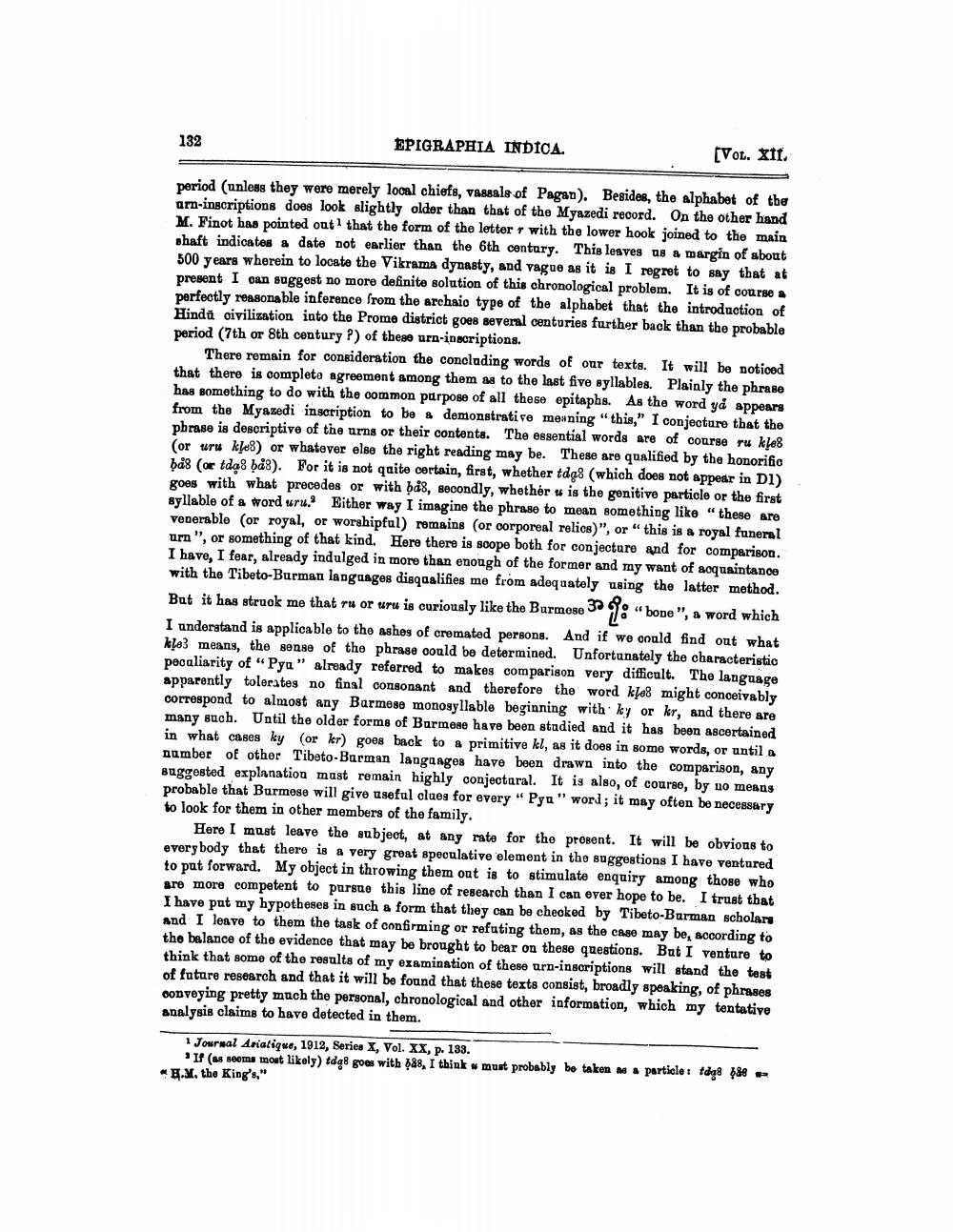________________
132
EPIGRAPHIA INDICA.
[Vol. Xir.
period (unless they were merely local chiefs, vassals of Pagan). Besides, the alphabet of the am-inscriptions does look slightly older than that of the Myazedi record. On the other hand M. Finot bas pointed out that the form of the letter with the lower hook joined to the main shaft indicates a date not earlier than the 6th century. This leaves us a margin of about 500 years wherein to locate the Vikrama dynasty, and vague as it is I regret to say that at present I can suggest no more definite solution of this chronological problem. It is of course a perfectly reasonable inference from the archaic type of the alphabet that the introduction of Hindi civilization into the Prome district goes several centuries further back than the probable period (7th or 8th century ?) of these urn-inscriptions.
There remain for consideration the concluding words of our texts. It will be noticed that there is complete agreement among them as to the last five syllables. Plainly the phrase has something to do with the common purpose of all these epitaphs. As the word ya appears from the Myazedi inscription to be & demonstrative meaning "this," I conjecture that the pbrase is descriptive of the urns or their contents. The essential words are of course ru kle8 (or uru kl.8) or whatever else the right reading may be. These are qualified by the honorifio bds (or tda8 bàs). For it is not qaite certain, first, whether tdal (which does not appear in Dl) goes with what precedes or with bd8, secondly, whether is the genitive particle or the first syllable of a word uru. Either way I imagine the phrase to mean something like "these are venerable (or royal, or worshipful) remains (or corporeal relics)", or "this is a royal funeral urn", or something of that kind. Here there is soope both for conjecture and for comparison. I have, I fear, already indulged in more than enough of the former and my want of acquaintance with the Tibeto-Burman languages disqualifies me from adequately using the latter method. But it has struok me that ru or uru is curiously like the Burmese 30 4: " bone", a word which I understand is applicable to the ashes of cremated persons. And if we could find out what kle3 means, the sense of the phrase could be determined. Unfortunately the characteristic peculiarity of "Pya" already referred to makes comparison very difficult. The language apparently tolerates no final consonant and therefore the word kle8 might conceivably correspond to almost any Barmose monosyllable beginning with ky or kr, and there are many such. Until the older forms of Burmese have been studied and it has been ascertained in what cases ky (or kr) goes back to a primitive kl, as it does in some words, or until a number of other Tibeto-Barman languages have been drawn into the comparison, any suggested explanation mast remain highly conjectaral. It is also, of course, by no means probable that Burmese will give useful clues for every " Pya" word; it may often be necessary to look for them in other members of the family.
Here I must leave the subject, at any rate for the prosent. It will be obvions to every body that there is a very great speculative element in the suggestions I have ventured to put forward. My object in throwing them out is to stimulate enquiry among those who are more competent to pursue this line of research than I can over hope to be. I trust that I have put my hypotheses in such a form that they can be cheoked by Tibeto-Burman scholars and I leave to them the task of confirming or refuting them, as the case may be, according to the balance of the evidence that may be brought to bear on these questions. But I venture to think that some of the results of my examination of these urn-inscriptions will stand the test of future research and that it will be found that these texts consist, broadly speaking, of phrases conveying pretty much the personal, chronological and other information, which my tentative analysis claims to have detected in them.
1 Journal Asiatique, 1912, Series X, Vol. XX, p. 133.
If (as seems most likely) td 8 goes with $88, I think must probably be taken a H.M. the King's,"
particle: tdq8 &




